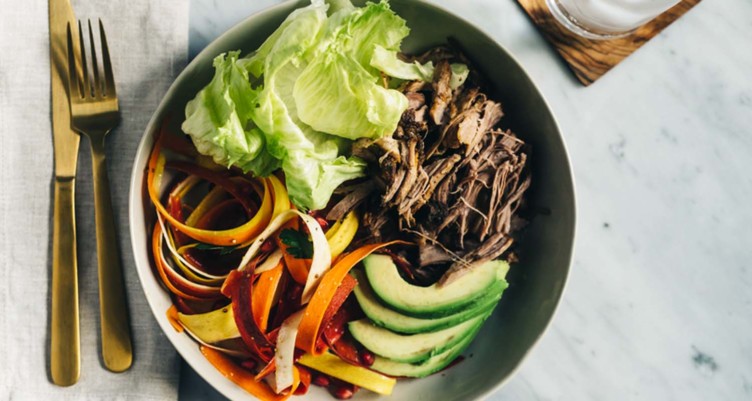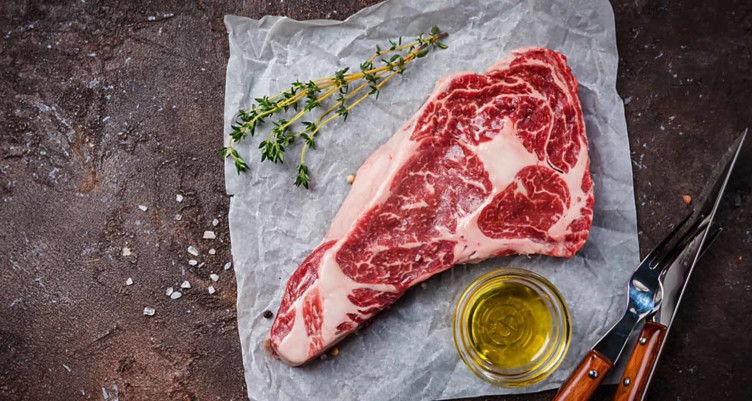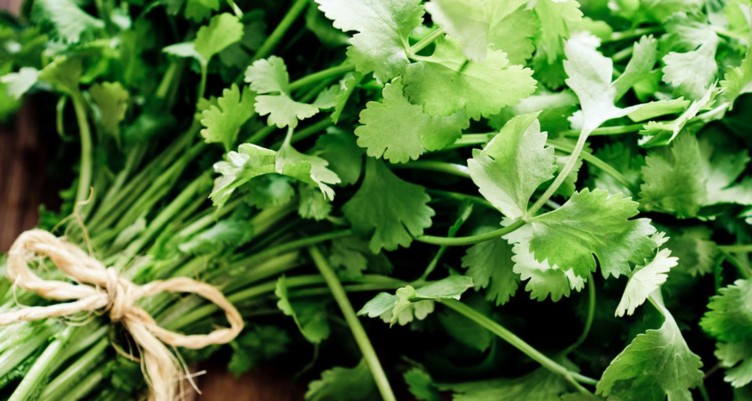Here’s How to Do the Whole30 and Be Bulletproof

- Whole30 is a 30-day clean-eating plan that removes the foods from your diet that typically cause you discomfort, distress, and poor health. Whereas the Whole30 allows mostly what our paleolithic ancestors ate – meat, plants, nuts, and seeds – the Bulletproof Diet takes a modern, science-based approach to food, analyzing how they affect the body on a biochemical level.
- Whole30 and Bulletproof Diets have distinct guidelines to macronutrients. Learn about appropriate fat, protein, and carb intake on each diet – as well as portion sizes.
- Whole30 rules suggest you focus on real food for the duration of the plan; in this way, Whole30 and Bulletproof are quite closely aligned. However, the specific food lists of each plan are different. To find out what specific foods you can eat on the Whole30 and Bulletproof diets, read on for a detailed Bulletproof and Whole30 food list.
- Get a printable infographic of all Bulletproof- and Whole30-approved foods here.
These days, diets are about weight loss, sure – but they also aim to help you find a healthier, happier approach to food, one that will make you look and feel your best. The Bulletproof Diet, born out of a decade of work with some of the world’s top health and nutrition researchers, eliminates foods that sap energy and pack on pounds to help you lose fat and gain energy and mental clarity. In that way, the Bulletproof Diet’s high-fat, low-carb, clean-eating approach is very similar to the Whole30 diet – with a few key differences. If you’re contemplating taking on a new diet in the name of a fitter physique and extraordinary resilience, read on to learn how you can supercharge your Whole30 diet by being Bulletproof as well.
Whole30 Diet vs the Bulletproof Diet
Commonly known as a stricter form of Paleo, Whole30 is a 30-day clean-eating plan that removes the foods from your diet that typically cause you discomfort, distress, and poor health. People generally use Whole30 as a body reset or even a weight-management plan. The Bulletproof Diet also focuses on removing toxic, health-sapping foods that weaken your willpower and fuel cravings.
Whereas the Whole30 allows mostly what our paleolithic ancestors ate – meat, plants, nuts, and seeds – the Bulletproof Diet takes a modern, science-based approach to food, analyzing how they affect the body on a biochemical level. For this reason, some foods allowed on the Whole30 food list are in the red zone on Bulletproof.
“Though the Bulletproof Diet is a lifelong strategy to feel good and prevent disease, there is an intensive, two-week portion of the diet that eliminates all potentially disruptive foods – also making it a good option for weight management.” You can get a full overview of the Bulletproof Diet for newbies here.
Whole30 and Bulletproof guide to macronutrients
According to the Whole30 meal plan, your plate should contain protein the size of the palm of your hand, a thumb-sized amount of fat, and a plateful of veggies. The goal of this approach is to steer you away from hyper-analyzing your food intake — no counting calories or macronutrients on this diet. Likewise, the Bulletproof Diet also discourages counting calories and carbs. However, Bulletproof is a type of ketogenic diet, where your body burns its own fat in the absence of carbs. For that reason, your plate on this high-fat, moderate-protein, low-carb meal plan looks a bit different. You’ll still eat the same amount of vegetables, but twice the amount of meat — and 50% to 70% of your calories will come from high-quality, healthy fats, like salmon, avocado, and grass-fed beef.
Bulletproof vs. Whole30 Food Lists
Whole30 rules suggest you focus on real food for the duration of the plan; in this way, Whole30 and Bulletproof are quite closely aligned.
On the Whole30 and Bulletproof diets, you specifically avoid all grains, soy, legumes, alcohol, sugar, and most dairy. Whole30 allows ghee only, while Bulletproof allows grass-fed butter and ghee. Another notable exception: All sweeteners are blacklisted on the Whole30 while some can be eaten on Bulletproof. (We’ll get more into the specifics below.) After 30 days on the Whole30 or two weeks on Bulletproof, you may slowly reintroduce some problematic foods back into your diet to see how your body reacts. In addition to the prohibited foods above, Bulletproof also axes several Whole30-approved foods that are inflammatory or moldy.
To find out what specific foods you can eat on the Whole30 and Bulletproof diets, read on for a detailed Bulletproof and Whole30 food list.
Beverages
On both diets, staying hydrated with water is key. Besides water, the other drinks that the two diets have in common are coffee, green tea, and coconut milk. As Bulletproof coffee is made with ghee (which is Whole30-approved), it is also a great bet on both diets. However, take note that the Bulletproof Diet allows only high-quality tea and coffee, to reduce exposure to mold toxins.
Whole30-approved beverages: Water, tea, coffee, coconut water, almond milk, and kombucha.
Bulletproof-approved beverages: Water, black or Bulletproof Coffee, green tea, diluted coconut milk, mineral water.
Vegetables
Both Whole30 and Bulletproof Diet are heavy on veggies, The Whole30 allows any and all vegetables, while Bulletproof advocates organic whenever possible. The Bulletproof Diet considers nightshades, mushrooms and other vegetables with high lectin or oxalate content suspect – meaning, they’re off-limits for the first two weeks. Then, you can add them in moderation to see how you feel. (Read more about lectins here.)
Whole30-approved veggies: All.
Bulletproof-approved veggies: Asparagus, avocado, bok choy, broccoli, brussels sprouts, cabbage, cauliflower, celery, collards, cucumber, fennel, kale, lettuces, olives, radishes, spinach, summer squash, zucchini.
Oils & Fats
Whole30 in general is a lower fat diet than the Bulletproof Diet. The one major point of agreement regarding oils and fats is that all forms of coconut are acceptable. Bulletproof oils (that are coconut-derived) like Brain Octane Oil and MCT oil, are also OK on Whole30. On the Bulletproof Diet, choose coconut oil over vegetable oil. Cacao butter, krill oil, grass-fed marrow, avocado oil, ghee (also listed under dairy), and sunflower lecithin are also clear on both diets.
Whole30-approved oils and fats: All forms of coconut oil (and coconut-derived oils), olive oil, canola oil, and cacao butter, krill oil, grass-fed marrow, avocado oil, coconut oil, sunflower lecithin.
Bulletproof-approved oils and fats: Brain Octane Oil, MCT oil, cacao butter, krill oil, grass-fed marrow, avocado oil, coconut oil, sunflower lecithin.
Nuts, Seeds, & Legumes
On the Bulletproof Diet, this food category can be tricky, due to the mold risk found in nuts, seeds, and legumes. They may also possess high levels of omega-6 fats that oxidize easily, causing inflammation. However, all nuts and seeds are OK on the Whole30. On both diets, you’ll avoid legumes – including all beans (black, red, pinto, navy, white, kidney, lima, fava, etc.), peas, chickpeas, lentils, and peanuts. No soy (in any form) either. There is one nut that both diets agree on: coconut. It’s anti-inflammatory, a high fat burner, and increases cognitive performance.
Whole30-approved nuts, seeds and legumes: All nuts and seeds. Green beans, sugar snap peas, and snow peas.
Bulletproof-approved nuts, seeds and legumes: Coconuts and cashews.
Dairy
Dairy is almost exclusively off-limits on both diets. The only dairy that’s both Bulletproof and Whole30-approved is ghee.
Whole30-approved dairy: Clarified butter or ghee.
Bulletproof-approved dairy: Organic grass-fed butter and ghee.
Meat & Seafood
Whole30 does not forbid any type of animal protein sources. The Bulletproof Diet advises eating only those that are high in omega-3s and low in inflammatory omega-6s. Because all animal protein is allowed on the Whole30, choose those allowed on the Bulletproof Diet (below) to stay compliant on both.
Whole30-approved meat: All.
Bulletproof-approved meat: Grass-fed beef and lamb, pastured eggs, and low-mercury wild-caught fish.
Starch & Grains
Avoid all grains on the Whole30 and Bulletproof diets, as they contain a ton of antinutrients like lectins, which can cause inflammation, brain fog, sore joints, poor complexion, and even migraines.
Whole30-approved grains & starches: No grains, no exceptions. That means corn, too. Choose starchy vegetables instead – butternut squash, carrots, cassava, plantain, pumpkin, sweet potato, taro, and yams.
Bulletproof-approved grains & starches: White rice.
Fruit
Eat as much fruit as you want on the Whole30. On the Bulletproof Diet, most fruits should be avoided – due to high sugar content and possibility of mold contamination.
Whole30-approved fruit: All.
Bulletproof-approved fruit: Avocado, blackberries, coconut, cranberries, lemon, lime, raspberries, blueberries, pineapple, strawberries, and tangerines.
Spices & Flavorings
Whole30 makes exceptions for all vinegar (but malt vinegar) on the program, though if you’re Bulletproof, stick to apple cider vinegar. Skip iodized salt, which has sugar in it, on both plans. The Bulletproof Diet advocates sea salt. Other spices and herbs that are allowed on both diets: cilantro, ginger, parsley, lavender, oregano, rosemary, thyme, and turmeric.
Whole30-approved spices and flavorings: White, red wine, balsamic, apple cider, and rice vinegar. Non-iodized salt, plus all herbs and spices (though be sure to read your labels).
Bulletproof-approved spices and flavorings: Apple cider vinegar, cilantro, coffee, ginger, parsley, lavender, oregano, rosemary, thyme, turmeric and sea salt. Read more about why salt quality matters here.
Sweeteners
Whereas the Whole30 diet forbids all sugar and sweeteners, the Bulletproof Diet allows ones that are natural, don’t have an impact on blood-sugar levels, and won’t take you out of ketosis. To be Whole30-compliant and Bulletproof, avoid all sweeteners.
Whole30-approved sweeteners: None, with the exception of fruit juice
Bulletproof-approved sweeteners: Xylitol, erythritol, stevia, sugar alcohols. Learn more about Bulletproof-friendly sweeteners here.
Alcohol
If you want to be Whole30- and Bulletproof-compliant, avoid all alcohol, period. To be Bulletproof also means keeping alcohol to a minimum, and for the first two weeks, avoiding it altogether.
Whole30-approved alcohol: None, not even for cooking.
Bulletproof-approved alcohol: None for the first two weeks. Thereafter, minimal amounts of clean, unsweetened, highly filtered and distilled spirits, like potato vodka, gin, and tequila. See the best and worst alcohol options here.
Additional note on goodies, sweets, and treats
Whole30 insists you not eat baked goods, junk foods, or treats with “approved” ingredients. The official Whole30 plan states: “Recreating or buying sweets, treats, and foods-with-no-brakes (even if the ingredients are technically compliant) is totally missing the point of the Whole30, and will compromise your life-changing results. These are the same foods that got you into health-trouble in the first place – and a pancake is still a pancake, even if it’s made with coconut flour. The list includes: pancakes, waffles, bread, tortillas, biscuits, muffins, cupcakes, cookies, brownies, pizza crust, cereal, or ice cream.”
Bulletproof disagrees. The Bulletproof diet allows for treats with “approved” ingredients. Remember, the goal here is to make Bulletproof a lifestyle that you will subscribe to – for life. That includes holiday and party treats once in a while – especially if they are made with healthy goodness all the way through. In fact, there is such a thing as Bulletproof ice cream. Avoid treats during your first two weeks of the Bulletproof Diet to see best results, though you can work treats back into your lifestyle thereafter.
One final note on Whole30 vs. Bulletproof
The Whole30 plan specifically states: “Do not step on the scale or take any body measurements for 30 days.” Bulletproof maintains while you don’t want to go overboard obsessing about the scale, Bulletproof fans biohack because they love to see, understand, and process results. For some people, measurements along the way can be helpful to progress. Bottom line: Be honest with yourself and do what works for you – that’s the goal, after all.
Get the printable infographic of all Bulletproof- and Whole30-approved foods here.
Sign up for early access to sales, product launches, the latest Bulletproof news and more!







